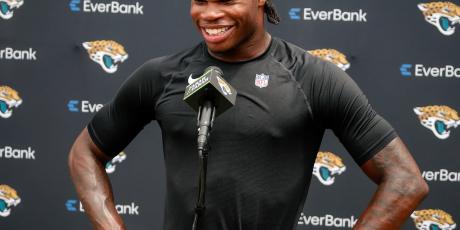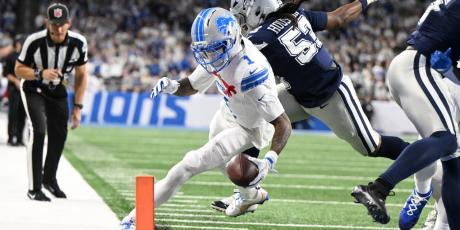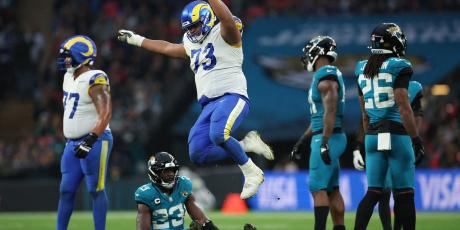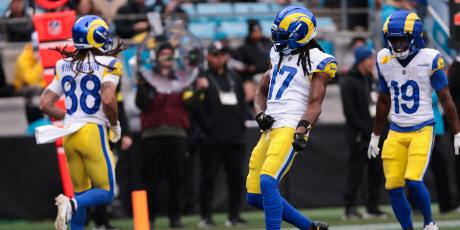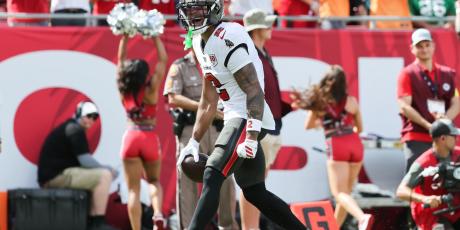Advocating for a Robust QB Approach in Superflex Dynasty

There is no one way to play fantasy football. There may be a style or format you enjoy most, or that works best for your skillset, but there are many ways to play the game—either very well or poorly. Superflex has become one of the more popular fantasy formats in recent years and this article will go over how to value quarterbacks in dynasty Superflex leagues, and why I prefer a robust approach to the position.
Quarterbacks are worth more in Superflex than they are in single-quarterback formats—both in terms of perception and reality. Last May, 4for4's own Greg Smith laid out a lot of the reasons why rostering quarterbacks in Superflex is a significant departure from traditional leagues. It's an informative read, especially if you are just getting started playing Superflex.
Before getting into how to approach the current talent pool at quarterback, let's hit on a few ideas and concepts, keeping in mind the variety of ways to play fantasy football.
Editor's Note: Looking for Dynasty Superflex Rankings? → George Kritikos's Top 200 Dynasty Superflex Rankings
Unlearning What You Know
One challenging aspect of transitioning to Superflex is, if you will, your muscle memory. Many of us have learned to regard quarterbacks as sort of a fantasy comfort food. We avoid them reflexively until we've consumed enough of the major food groups. If you are a long-time single-quarterback player, as I was, you'll want to make sure you do some reprogramming before you participate in your first Superflex startup. Make the mental shift in advance. In a Superflex startup, quarterbacks are a superfood. Indulge away!
Quarterbacks Versus Running Backs
In Superflex dynasty, I value quarterbacks a lot like running backs, but there is one compelling difference. The long-term elite quarterback. The usable shelf life of a legitimately good NFL starter is as much as 20 years. We all know the names. A quarterback can play a decade in the NFL and still have five good years left. This makes a particular subset of the quarterback pool exceedingly valuable. We want to have a predatory mindset with this group. Just as importantly, we want to have a firm grasp of which quarterbacks do and do not fall into this category. More on that later.
Never.Stop.Acquiring.Quarterbacks
I've often said I would never stop drafting quarterbacks if I ran an NFL team. Quarterback is by far, the most valuable position in the league. When you hit on a quarterback in the draft, the profit margins dwarf what you would find with any other player. Any time I saw a quarterback value, based on my draft board, I would be looking to draft him and potentially flip him.
When you look at the recent Matthew Stafford-Jared Goff deal and what's being floated as fair compensation for Deshaun Watson, you get a window into how NFL teams value the position. And it's not just for high-end starters. Take a look at the money paid for Kirk Cousins when he hit the open market. Case Keenum is an even better example. Look at what backup quarterbacks get paid. Look at some of Andy Reid's deals back when he was in Philadelphia. If you're not sure what I am talking about, try googling A.J. Feeley or Kevin Kolb.
In the NFL, as we see above, many teams will get taken to the cleaners if they have a significant need at quarterback. I've seen the same thing happen multiple times in Superflex dynasty. This is a scenario worth avoiding, proactively. The same logic that says "fortify the quarterback position" would also say having a surplus at quarterback puts you in a position to profit.
In Superflex dynasty, I operate much the same way as I would as an NFL GM. Commit to being strong at the quarterback position, and when that's achieved, keep going. Never stop grinding and scrounging for more. As long as the price is right, acquire quarterbacks in pretty much any way possible. The thing to avoid is buying on your competition's terms. What you want to achieve is having quarterback depth you can profit from.
And unlike the NFL, this is an uncomplicated process in our world. There are no egos to bruise in fantasy. Players don't mind if they are a starting-caliber player who sits on your bench. Everybody gets the same number of practice reps and no player agents have your cell number. Moreover, in fantasy, all players are scheme fits.
The Art of Quarterback Hoarding
If you've seen enough Superflex startup drafts, then you know what quarterback hoarding looks like. Some team starts off a draft with five consecutive quarterbacks or something to that effect. The idea is to create a shortage at the most valuable position while you, and perhaps another team or two, are holding the surplus.
Is it a crazy move? Not at all, and depending on which quarterbacks you draft, it can work out really well. The key is winning the subsequent trades cleanly. If you aren't doing that, then you're adding significant legwork without much benefit. Make sure you possess the required skillset to make the tactic pay off. One caveat that I would add with a hoarding approach is to never disregard the human element. When you box people out at a startup draft, you may see some tempers flare. If you opt to go down this path, be prepared to hold your assets while your competition works through the stages of grief, if you will. With some patience, you should eventually be able to make the deals you need to make.
Some of you might be wondering what the difference is between a robust quarterback approach and hoarding. In my view, hoarding means you're trying to create an asymmetrical market. A robust approach is more about prioritizing the position and getting what you want at the startup, where, in my experience, the cost of acquiring quarterbacks tends to be the lowest.
"Everyone has a plan until they've been hit." — Joe Louis
We all have a plan. And, no matter what plan we choose to implement, there will be potentially bad outcomes. The question is, in the face of bad outcomes, is our plan fragile or robust? Can the team you built take a hit?
If we think about our early picks in a startup as foundational pieces, as most of us do, then they probably ought to serve that purpose, right?
Here's a real-life example from a 2017 Superflex startup: The quarterback landscape was obviously different back then. The team drafting at 1.08 was in a good position. Only Andrew Luck had been selected at that point. On my board, both Aaron Rodgers (33 at the time) and Russell Wilson were sticking out like sore thumbs. There is no doubt one of those two should have been selected.
Instead, the pick was Jameis Winston.
It's easy to mock that selection now because Winston lost his job and is currently a backup. The question is, why was Winston a weak foundational pick, even before he failed? The reason is he had too many potential fatal flaws. Winston was a good, solid talent but not a great one. Right there we have some reason for concern. Winston was turnover-prone and still trying to get over that hump. Winston also had off-field incidents that were, quite fairly, seen as potentially problematic. Winston played for Tampa Bay—an organization far from elite at the time, who had cycled through four head coaches in a seven-year span.
In short, Winston was a desirable upside option for a few reasons, but he did not fit the archetype of the foundational piece you want in the first two rounds of a startup draft. You leave yourself wide open when you assume that much risk.
Taking a quarterback was not his problem—drafting a non-elite quarterback that high was his problem. Winston was not the keystone to a strong foundation, making the building vulnerable from the start. If he had gone with Wilson or Rodgers, he'd have been far better off. Not because of the eventual outcomes, but because both players were proven foundational talents. These are the kind of assets you want to build a Superflex team around if you want it to be able to take a hit.
Embrace the Contours of Superflex
In the old days, before the airplane, armies built their fortresses on hilltops. One of the primary reasons was that it takes far fewer men to defend a well-fortified hill than it does to take it. Think Saving Private Ryan and Normandy. Think Lord of the Rings—specifically the Two Towers and the Battle of Helm's Deep.
It has been my experience in Superflex Dynasty that building strong and early at quarterback can create much the same paradigm as you find with the fortress on a hill. The status quo favors you. It also costs you less to maintain what you have built because you can add more quarterbacks when good buying opportunities arise, rather than buying due to need.
One thing I have seen consistently in Superflex dynasty leagues is that quarterbacks get more costly as the league evolves. One of my favorite leagues is a 56-team Superflex dynasty format run by Scott Fish called Capitalist Pigs. Heading into the startup auction I was committed to being strong at quarterback. When the smoke cleared, I had spent more than 40% of my total budget on four quarterbacks.
- Russell Wilson: $180
- Dak Prescott: $205
- Patrick Mahomes: $87
- Sam Bradford: $41
I added plenty of other players who were important cogs for my team, but this quarterback foursome was absolutely the cornerstone. I won the league title in 2018, all thanks to the strength at quarterback, and was able to keep my title window wide open. I sold Bradford for $150. With Mahomes established, I was able to deal Prescott for a windfall of $300, plus first-, second- and third-round draft picks. The team is still in a winning window as we enter 2021. I'd love to tell you my keen eye for talent was the driving force behind my team's success, but in truth, being strong at quarterback was a huge positive factor. It put a lot of wind in my team's sails.
Metaphorically speaking, my first desired move in a Superflex dynasty league is to seek the higher ground and establish an elevated position on Quarterback Hill.
Let's revisit Joe Louis for a second. Teams with strength at the quarterback spot can take a punch and if they do get knocked down, it's a whole lot easier for them to get back up. The plan is robust.
"I'd rather be a hammer than a nail." — Simon & Garfunkel
Everybody wants the hammer. You don't need me to tell you that you get better outcomes when dealing from a position of strength. It's true in real life and it's true in fantasy football. However, in Superflex dynasty, a well-constructed roster can beget even more roster strength, like a snowball rolling downhill.
In Superflex, once you earn a good grip on the hammer, it's hard to get that thing out of your hands. In fact, if given the choice, I'd rather be an elite team in a Superflex league than in a single-quarterback format. For starters, the rookie draft penalty tends to be less severe in Superflex.
In a typical single-quarterback format, the value is with the running backs and next up would be the receivers. I think we all understand this is the case. Quarterbacks drafted in round one of single-quarterback rookie drafts is rare. More often than not, there are zero taken. Conversely, I have seen as many as six quarterbacks taken in the first round of a Superflex rookie draft. Think about what that means for teams who draft towards the end of the round. They end up getting talent that would typically go in the middle of round one. If we think about the rookie draft allotment as a form of taxation, you are getting taxed a lot less for your successes in Superflex. Check out 4for4's Dynasty Lead George Kritikos's Top 200 Superflex Dynasty Ranks to see where he values quarterbacks in the format.
Some of you may be saying, "but what if I tend to trade my picks away"? Like I said at the top, there are a lot of smart ways to play this game. Moving draft picks for more proven talent is a solid tactic that a lot of folks have had success with. Just make sure you've made the mental shift we talked about earlier. Projected late-first-rounders have more value in Superflex. If you're not getting trade value commensurate with that bump, consider holding onto the pick or continuing to negotiate.
In Superflex, avoiding acute need is more complex than in single-quarterback leagues, because you have two positions of scarcity rather than just one. Those positions being running back and quarterback. So there are more ways to get yourself into trouble. And, if you are a team holding the hammer, there should be plenty of nails you can pound.
I saw Ke'Shawn Vaughn taken in the first round, ahead of Justin Jefferson, in two different leagues last year. Now we could do a few thousand words on why that was bad, but for our purposes here, that's what need drafting looks like. It's not pretty in the moment, and it gets uglier with the passage of time.
This is another reason why building with a robust approach at quarterback and also running back can help you gain a fortified position on your league's hill. Once you are there, the status quo is your ally. You can deal from a position of strength and that leads to more favorable outcomes.
Think about how this can work in your favor. You build strong at the two key spots and you construct a strong enough overall team to be a contender. This puts you somewhere in the back half of the first round of your rookie draft—hopefully last.
Again, the Superflex dynamic really works for you here. You built strong at quarterback and running back. Those are the two positions that will be prioritized in your rookie draft. Your team build left you with relative weakness at wide receiver, and that is the position that tends to get pushed down by the elevated quarterbacks. Strength begets strength and the contours of the format are working with you, not against you. I'm not saying it's as easy as 1-2-3 to get there, but I want that hammer.
Identify Elite Long-Term Quarterbacks
One of the big dangers, when you draft for fantasy, is losing your handle on where the tier drop-offs are. We always want to avoid the next-guy-on-the-list mentality. This is doubly true when we're going with the robust quarterback approach in a Superflex startup. We want to avoid getting felled by one hit to the face. We want to avoid the Jameis Winston scenario.
My preferred way of doing this is to have a deep understanding of the quarterback pool as it relates to Superflex value, and knowing when it's time to pivot.
As I said earlier, I value running backs and quarterbacks similarly in Superflex. The primary difference being the long-term elite quarterback. Let's go back to Jameis Winston again, but this time, let's compare him to the one truly elite quarterback in Superflex dynasty today, Patrick Mahomes.
Now we all know Mahomes is better than Winston. Even Winston knows it. However, as I said earlier, Winston was a bad choice as a foundational pick (ahead of Wilson and Rodgers) even before the outcome was known. It was a bad process pick. Here's why...
We know Mahomes is truly great and Winston is a middling talent, but it's the entire balance sheet we need to consider:
- Mahomes has zero character concerns.
- Mahomes plays for a more stable organization.
- Mahomes plays with fellow elite talents like Travis Kelce and Tyreek Hill.
- Mahomes was drafted by Andy Reid, a well-known quarterback guru.
- Mahomes is only 25 years old.
Looking at all of that, it should come as no surprise Mahomes is usually the first player taken in Superflex startup drafts. Just to be clear, if I had the 1.01 in a startup, I'm taking Mahomes without batting an eye. Easiest call ever. And no, I did not drop over 4,000 words just to say "take Mahomes." He's just the best example of the kind of quarterback we want to target. He checks every single box on my checklist. Most of them emphatically. He's in a tier of his own when it comes to my Superflex rankings. The first 10 players on my board are quarterbacks, broken down into three tiers:
Tier 1
Tier, party of one.
Tier 2
This is a very tightly-grouped and crucial tier. You can move players anywhere you want within this tier and you'll get no push back from me. Any of these options work as first-round selections in a startup.
Tier 3
This is my last group of early targets. If I can leave round two of my startup with a pair from these first three tiers, I'll be content and ready to crush the rest of the draft. And, unlike in single-quarterback leagues, I have not limited my options going forward. If I am on the clock and the best option is a quarterback, I can still take one.
Bottom Line
- The ideal draft start is three quarterbacks and three running backs. I have room to move if an exceptional value emerges at tight end, especially in a TE-premium format. The value at wide receiver would need to be more extreme, but they can enter the mix in certain cases. For the rest of the startup, continue to add quarterbacks, if and when the value is available.
- Using a robust quarterback approach pays dividends in Superflex leagues. Your league may throw you some curveballs, forcing you to modify your approach, but in the end, that's why this game is such a wonderful challenge.
Related Articles





